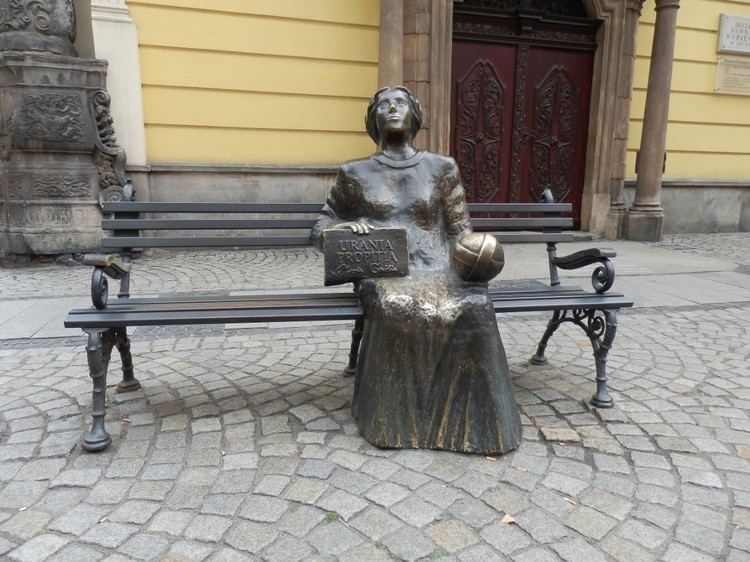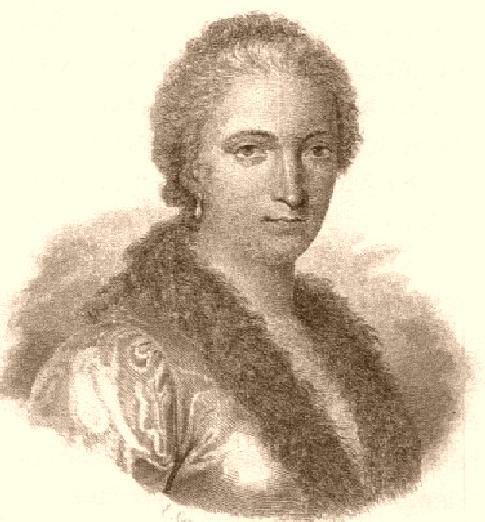Name Maria Cunitz | Role Astronomer | |
 | ||
Similar Elisabeth Hevelius, Peter Crüger, Matthias Bernegger Born 1610 Wohlau, Duchy of Legnica, Holy Roman Empire Died 22 August, 1664 (aged 53–54) Pitschen, Duchy of Legnica, Holy Roman Empire Known for Urania propitia Spouses David von Gerstmann (m. 1623), Elias von Löwen (m. 1630) Children 3 Fields Astronomy, mathematics Academic advisors Elias von Löwen | ||
Maria_cunitz.wmv
Maria Cunitz or Maria Cunitia (other versions of surname include: Cunicia, Cunitzin, Kunic, Cunitiae, Kunicia, Kunicka) (Wołów, Silesia, 1610 – Byczyna, Silesia, August 22, 1664) was an accomplished German astronomer, and one of the most notable female astronomers of the modern era. She authored a book Urania propitia, in which she provided new tables, new ephemera, and a more elegant solution to Kepler's problem. The Cunitz crater on Venus is named after her. The minor planet 12624 Mariacunitia is named in her honour.
Contents

Life

Maria Cunitz was born in Wohlau (now Wołów, Poland), as the eldest daughter of a Baltic German, Dr. Heinrich Cunitz, a physician and landowner who had lived in Schweidnitz for most of his life, and Maria Scholtz from Liegnitz, daughter of German scientist Anton von Scholtz (1560–1622), a mathematician and counselor to Duke Joachim Frederick of Liegnitz. The family eventually moved to Schweidnitz in Lower Silesia (today Świdnica, Poland). At an early age Maria married (in 1623) the lawyer David von Gerstmann. After his death in 1626, she married (in 1630) Dr. Elias von Löwen, also from Silesia. Elias and Maria had three sons: Elias Theodor, Anton Heinrich and Franz Ludwig.

Maria's most significant work was composed on the estate of the Cistercian convent in Łubnice under Ołobok near Kalisz, Poland where, with her husband, she had taken refuge at the outbreak of the Thirty Years' War (they were of Protestant religion; her siblings, who stayed in Silesia, converted to Roman Catholicism). After their return to Silesia, they published, at their own expense, Maria's book in 1650. The work was dedicated to Holy Roman emperor Ferdinand III. In 1655, a catastrophic fire of Pitschen (Polish: Byczyna) destroyed their scientific papers, and also the instruments and chemicals used for making many types of medicines. This undercut their source of income. Maria became a widow (a woman whose spouse has died) in 1661, and died at Pitzen in 1664.

The year of Maria's birth is uncertain. No birth, baptism or similar documents have ever been located. The year was speculated about in the first major German-language publication about Maria Cunitz of 1798. Dr. Paul Knötel appears to be the first to give the year 1604 as the year of Maria's birth. This date seemed to make sense since her parents married the previous year. Other authors later appear to have repeated the same year. The proof that Maria was actually born in 1610 is furnished by an anthology with congratulation poems on her first wedding, in connection with a letter of Elias A Leonibus to Johannes Hevelius from the year 1651, found recently by Dr. Ingrid Guentherodt.
Accomplishments
The publication of the book Urania propitia (Olse, Silesia, 1650) gained Cunitz a European reputation. She was acclaimed as the most learned woman in astronomy since Hypatia of Alexandria. Significantly for a technical publication of that period, her book was written both in Latin and German (stating that it was to increase the accessibility to her work). Urania propitia was a simplification of the Rudolphine Tables. It provided new tables, new ephemera, and a more elegant solution to Kepler's Problem, which is to determine the position of a planet in its orbit as a function of time. Today, her book is also credited for its contribution to the development of the German scientific language.
Because of her many talents and accomplishments, Cunitz was called the "Silesian Pallas". In his 1727 book Schlesiens Hoch- und Wohlgelehrtes Frauenzimmer, nebst unterschiedenen Poetinnen..., Johan Caspar Eberti wrote that
(Maria) Cunicia or Cunitzin was the daughter of the famous Henrici Cunitii. She was a well-educated woman, like a queen among the Silesian womanhood. She was able to converse in seven languages, German, Italian, French, Polish, Latin, Greek and Hebrew, was an experienced musician and an accomplished painter. She was a dedicated astrologist and especially enjoyed astronomical problems.
Nationality
Maria Cunitz is usually characterized as Silesian, for example in the Encyclopædia Britannica Eleventh Edition of 1911. She was born and spent most of her life in the Holy Roman Empire, which included non-German minorities, ruled by the Austrian Habsburg Monarchy. The fragment of Silesia in which Maria lived was part of Bohemia before 990, the united Poland between 990 and 1202 and part of Bohemia between 1038 and 1050. In 1202 the Polish seniorate was abolished and all Polish Duchies, including Silesia, became independent, although four Silesian dukes of the 13th century were rulers of Kraków and held the title Duke of Poland. In 1331 the region again became part of Bohemia. In 1742 it become part of Prussia and in 1871 the German Empire. About three centuries after Maria's lifetime it was reassigned to Poland after World War II.
During Maria's lifetime, nationality did not play as significant a role in determining person's identity as it does today. Nevertheless, multiple later sources felt the need to assign to Maria Cunitz a nationality relevant to their own time. She has mostly been described as German, for example in Bibliographical Dictionary of Woman in Science. She published in German. She has been also described as Polish and some consider her to be the first Polish woman astronomer. Cunitz spoke not only German and Polish but also French, Greek, Italian, Latin and Hebrew.
